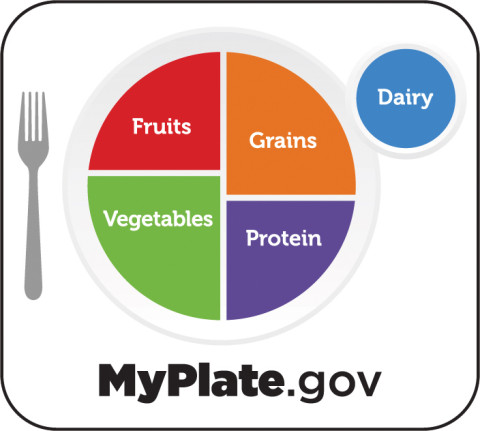MyPlate Food Guide
The U.S. Department of Agriculture (USDA) created MyPlate, an easy-to-follow food guide, to help parents to figure out how to feed their kids nutritious, balanced meals.
The colorful divided plate includes sections for vegetables, fruits, grains, and protein foods. MyPlate's user-friendly, interactive website provides simple messages, such as:
- choose variety — the best meals have a balance of items from different food groups
- fill half your child's plate with vegetables and fruits
- make at least half the grains you serve whole grains, like oatmeal, whole-wheat bread, and brown rice
- serve fat-free or low-fat (1%) milk and water rather than sugary drinks
- don't serve oversized portions
How to Make MyPlate Yours
Just by looking at MyPlate, you know right away that vegetables and fruits should take up half the plate and grains and protein foods each take up about a quarter of the plate. And with a side helping of dairy, you're reminded to include milk or another dairy food (like cheese or yogurt) in your daily meal plan.
But you might wonder: Do I have to serve all the food groups at each meal? Do I really have to give my kids veggies for breakfast? After all, it might be hard enough to get them to eat them at lunch or dinner. If breakfast doesn't include a veggie, try fruit instead. Include fruit and veggies with lunch and give them at snack time. Use the plate as a guide to planning and serving a variety of healthy foods.
Think of the plate as an entire day's worth of eating: So, throughout the day, try to make half of what your kids eat vegetables and fruits, and the other half grains and protein foods. An occasional treat is fine, but be careful to limit foods that are high in calories and low in nutrients.
If you're thinking it might be hard to get your kids to take a bite off this new plate, practice what you preach. MyPlate is not just for kids, but for adults too. Kids who see their parents eating healthy foods are more likely to do so themselves.
Green = Vegetables
The vegetable portion of MyPlate, in green, is the largest section on the plate. Vegetables have many of the vitamins and minerals kids need for good health, are naturally low in calories, and contain fiber. The vegetable group includes:
- dark green vegetables (like broccoli, spinach, and kale)
- orange and red vegetables (like squash, carrots, and sweet potatoes)
- beans and peas (like kidney beans, lentils, and black-eyed peas — also included in the protein group)
- starchy vegetables (like corn, potatoes, and plantains)
- other vegetables (those that don't fall into the first four categories, like cauliflower and green beans)
For best nutrition, serve a variety of vegetables to your family each week. You can use fresh, frozen, or canned veggies.
Red = Fruits
Fruits are an important part of a balanced diet. They contain nutrients like vitamin C, potassium, and fiber. You can use fresh, frozen, or canned fruit.
When buying canned fruit, choose fruit packed in juice rather than heavy or light syrup. And it's best to serve whole fruit over 100% fruit juice. Fruit juices have more sugar and calories with less fiber per serving than whole fruit.
Orange = Grains
The grain group includes any food made from wheat, oats, cornmeal, barley, or other grain. Bread, tortillas, cereal, rice, and pasta belong in this group.
At least half of the grains kids eat each day should be whole grains, such as oatmeal, brown rice, and whole-wheat bread. Whole grains have dietary fiber that helps kids feel full and can prevent and treat constipation. Eating a diet rich in whole grains also might decrease the chances of getting heart disease and diabetes.
Refined grains, like white bread and white rice, are more processed, removing many of the nutrients. Most refined grains are enriched, which means that nutrients, except fiber, are added back after processing.
Purple = Protein Foods
Foods that are high in protein help the body build and maintain muscles, skin, blood, and other tissues of the body. They also have important vitamins and minerals, like iron.
Protein-rich foods include beef, poultry, seafood, dry beans and peas, eggs, nuts, and seeds. Soy products like tofu and veggie burgers are also good sources of protein. When eating meats, choose lean or low-fat options.
Blue = Dairy
This group includes milk and other dairy products, such as yogurt and cheese. Calcium-fortified soy milk and soy yogurt are also included in the dairy group. Besides calcium, dairy products have protein and vitamin D. Vitamin D helps the body absorb calcium for healthy bones and teeth. Foods made from milk, like butter, cream, and cream cheese, don't have much calcium, and are not part of the dairy group.
Serve low-fat or nonfat milk and dairy products to kids over 2 years old.
Find Out More
MyPlate is as a guide for healthy eating. Talk to your health care provider if you are concerned about your child's eating habits.
Visit the USDA's MyPlate website for daily checklists, recipes and tips, and interactive tools.



